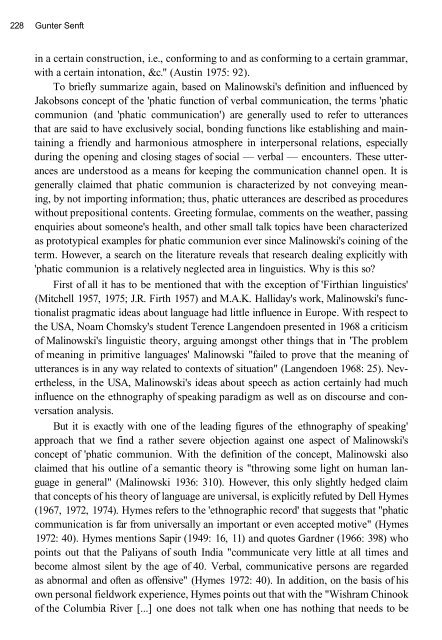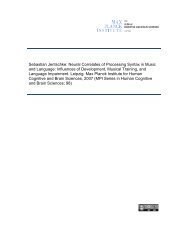Phatic communion - PubMan
Phatic communion - PubMan
Phatic communion - PubMan
You also want an ePaper? Increase the reach of your titles
YUMPU automatically turns print PDFs into web optimized ePapers that Google loves.
228 Gunter Senft<br />
in a certain construction, i.e., conforming to and as conforming to a certain grammar,<br />
with a certain intonation, &c." (Austin 1975: 92).<br />
To briefly summarize again, based on Malinowski's definition and influenced by<br />
Jakobsons concept of the 'phatic function of verbal communication, the terms 'phatic<br />
<strong>communion</strong> (and 'phatic communication') are generally used to refer to utterances<br />
that are said to have exclusively social, bonding functions like establishing and maintaining<br />
a friendly and harmonious atmosphere in interpersonal relations, especially<br />
during the opening and closing stages of social — verbal — encounters. These utterances<br />
are understood as a means for keeping the communication channel open. It is<br />
generally claimed that phatic <strong>communion</strong> is characterized by not conveying meaning,<br />
by not importing information; thus, phatic utterances are described as procedures<br />
without prepositional contents. Greeting formulae, comments on the weather, passing<br />
enquiries about someone's health, and other small talk topics have been characterized<br />
as prototypical examples for phatic <strong>communion</strong> ever since Malinowski's coining of the<br />
term. However, a search on the literature reveals that research dealing explicitly with<br />
'phatic <strong>communion</strong> is a relatively neglected area in linguistics. Why is this so?<br />
First of all it has to be mentioned that with the exception of 'Firthian linguistics'<br />
(Mitchell 1957, 1975; J.R. Firth 1957) and M.A.K. Halliday's work, Malinowski's functionalist<br />
pragmatic ideas about language had little influence in Europe. With respect to<br />
the USA, Noam Chomsky's student Terence Langendoen presented in 1968 a criticism<br />
of Malinowski's linguistic theory, arguing amongst other things that in 'The problem<br />
of meaning in primitive languages' Malinowski "failed to prove that the meaning of<br />
utterances is in any way related to contexts of situation" (Langendoen 1968: 25). Nevertheless,<br />
in the USA, Malinowski's ideas about speech as action certainly had much<br />
influence on the ethnography of speaking paradigm as well as on discourse and conversation<br />
analysis.<br />
But it is exactly with one of the leading figures of the ethnography of speaking'<br />
approach that we find a rather severe objection against one aspect of Malinowski's<br />
concept of 'phatic <strong>communion</strong>. With the definition of the concept, Malinowski also<br />
claimed that his outline of a semantic theory is "throwing some light on human language<br />
in general" (Malinowski 1936: 310). However, this only slightly hedged claim<br />
that concepts of his theory of language are universal, is explicitly refuted by Dell Hymes<br />
(1967, 1972, 1974). Hymes refers to the 'ethnographic record' that suggests that "phatic<br />
communication is far from universally an important or even accepted motive" (Hymes<br />
1972: 40). Hymes mentions Sapir (1949: 16, 11) and quotes Gardner (1966: 398) who<br />
points out that the Paliyans of south India "communicate very little at all times and<br />
become almost silent by the age of 40. Verbal, communicative persons are regarded<br />
as abnormal and often as offensive" (Hymes 1972: 40). In addition, on the basis of his<br />
own personal fieldwork experience, Hymes points out that with the "Wishram Chinook<br />
of the Columbia River [...] one does not talk when one has nothing that needs to be












